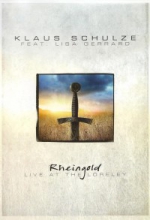MENNO VON BRUCKEN FOCK
RHEINGOLD (E)

Klaus Schulze needs no introduction. This pioneer of electronic music is well-known throughout the world. After recovering from a serious illness a few years ago, he is performing live after an hiatus of over five years and he still makes albums as well as supervising all the re-releases of his older albums. Lisa Gerrard is known from her work with Dead Can Dance. She performed with Schulze before on his album Farscape (2008). Upon the warm welcome Schulze receives from the audience at the Loreley Festival in July 18th, 2008, Schulze expresses his gratitude that he’s able to perform live again. On Rheingold Schulze starts off solo with Alberich a long track, opening very gentle and subsequently adding his characteristic sequences and rhythm patterns. On top of that you'll hear some slow melodies. The movements of his hands not always seems to match all the different sounds coming from the impressive amount of machinery, built up around and behind the artist. That machinery, samples, loops, computers and delays are responsible for that of course, but for outsiders it’s still strange that there's so much music coming from so little physical effort. The Loreley features Gerrard's vocals, expressing a wide range and dynamics with her voice. The performance consists of mere improvisation and while the sequencers are pounding, Schulze creates the perfect ambiance for Gerrard. In the second part the sequences fade away and it’s mainly vocals and only some distant sounds. He didn’t even have to put his finger on his mouth as he did occasionally to prevent the audience to make too much noise, because the audience was already listening intensely in spite of the minimalistic sounds. A bit too ‘minimalistic’ for my taste, however.
Roaring sounds, a lot of sequencer and leads - the Moog system is not always in harmony with the background - plus a nicely hammering rhythm in the third track Wotan. Schulze plays his Moog bringing the audience to ecstasy. Lisa Gerrard returns with a solo performance in Wellgunde, while Schulze joins her a bit later with smooth orchestrations. The vocals and the keyboards are not always in harmony as could be expected from improvisation and although the atmosphere is superb, it’s not my cup of tea. The whole performance of course is fairly static, so from a spectator’s point of view the show is very sober. The ambiance is great, the atmosphere is superb and the lightshow is tasteful but sober. As an encore, Klaus Schulze plays Nothung, a genuine masterpiece in the very best Schulze tradition: nice sequences, crystal clear sounds, fine melodies and a solid rhythm. The extra studio track Nibelungen, another referrence to Schulze’s hero Richard Wagner, is not available on the promotional copy, so it could not be reviewed. This piece of music is probably well-worth listening to, as it is over 31 minutes.
Cd2 contains ‘the real world of Klaus Schulze’, a documentary about Schulze and his crew working on the remix of the Rheingold concert in the Real World Studio in England. In between Schulze tells tales about his past, he checks out the studio and it’s huge mixing facilities and awesome surround system. He also explains why and how he and Lisa Gerrard got in touch. In the long interview - over an hour - with Steven Wilson (Porcupine Tree), Schulze talks about his views on music, how his records came to be and about the technological developments and the way these have influenced his music and career. Both artists agree the seventies were by far the most interesting years with regard to creativity and originality and that the record labels in those days were mostly led by dedicated people with a genuine interest in music, unlike most companies nowadays. Schulze states that SPV is one of the few exceptions. This DVD or double live CD, is obviously a must for Schulze and/or Gerrard fans. Not anyone would forgive the moog to be slightly out of tune and not everyone will be blown away by Gerrard’s voice and though there are some superb sequences, I’d suggest to listen before buying.